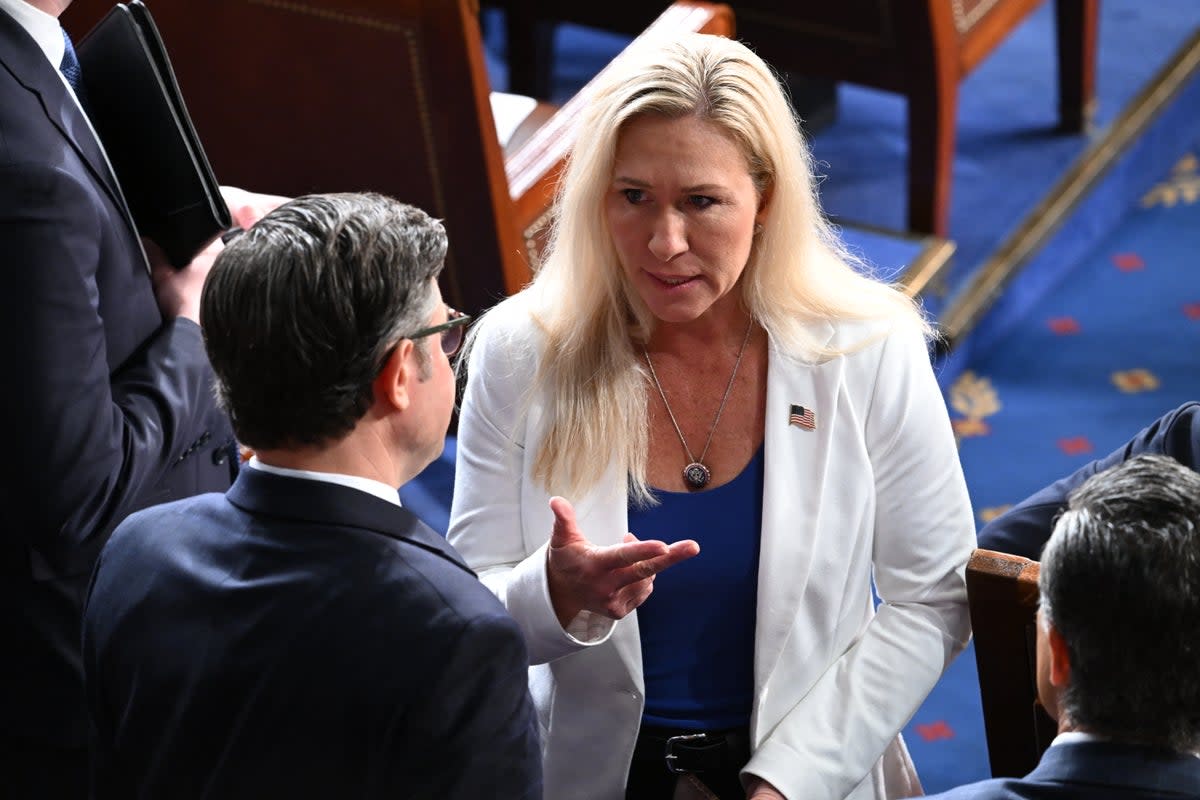The bizarre feud between former allies Marjorie Taylor Greene and Mike Johnson, explained

On Tuesday, Representative Marjorie Taylor Greene and House Speaker Mike Johnson will meet once again as Johnson seeks to talk down Greene’s plans to remove Johnson from his job. Greene would do that by triggering a motion to vacate, effectively turfing him out of the speakership if she can get enough votes in support. How did it come to this?
On the surface, the two should be natural allies. Both are hardline conservatives and ardent supporters of former president Donald Trump. Both voted to object to the 2020 presidential election results after January 6 and both have made a point of criticizing President Joe Biden on immigration policy.
But prior to his ascent as speaker, few people had heard of Johnson — whereas Greene was one of the most visible faces of the pro-MAGA wing of the Republican Party.
How it all began
After Republicans took back the House of Representatives in 2022, Greene closely aligned herself with House Speaker Kevin McCarthy on the grounds that Republicans needed to be unified to investigate Biden’s administration. As a junior member of House leadership, Johnson also voted for McCarthy all 15 rounds it took before McCarthy ultimately earned the gavel.
In addition, Greene emerged as the loudest opponent in the GOP of providing aid to Ukraine. In the previous Congress, Johnson also voted against providing aid to Ukraine.
In September of last year, after protracted negotiations with hardline conservatives, McCarthy put a stopgap spending bill to the floor to keep the government open — but without providing aid to Ukraine.
That triggered Representative Matt Gaetz to file a motion to vacate against McCarthy, which both Johnson and Greene opposed. The three-week search for a replacement began. Johnson, who first won election in 2016 and served as vice chairman of the House Republican conference, emerged as the consensus choice. All House Republicans — Greene included — voted for him.
How the split happened
Initially, Greene and Johnson were unified in opposing aid to Ukraine. Johnson later killed a bipartisan deal in the Senate that would have provided aid to Israel, Ukraine and Taiwan in exchange for restrictions to immigration and additional security measures at the US-Mexico border. After the Senate passed a standalone bill, Johnson refused to put the bill to the floor.
Republicans only have 217 members compared to Democrats’ 213, giving Johnson an incredibly thin majority. Given that a handful of hardliners will oppose almost any piece of legislation put to the floor, that gives Johnson an even slimmer majority to navigate.
Greene had initially said she would file a motion to vacate against Johnson if he put aid to Ukraine on the floor. But even before then, Greene had expressed dissatisfaction in Johnson when he worked with Democrats to pass the 12 spending bills to keep the government open for the rest of the fiscal year.
“We’re breaking all the rules,” she told The Independent in March. “Remember the precious rules of the Republican Conference?”
The day of the vote for the second batch of spending bills, Greene had clearly had enough — and she filed her motion to vacate.
What is the motion to vacate — and why is Greene’s different from Gaetz’s?
The motion to vacate the chair at its core triggers a no-confidence vote in the speaker of the House of Representatives. Since the Tea Party era, conservatives have used the motion to vacate as a threat against Republican speakers. But in the past, conservatives did not make the resolution “privileged,” which triggers a vote within two legislative days.
As part of McCarthy’s deal with hardline conservatives to vote to make him speaker, he allowed for one member to file a motion to vacate. In October, Gaetz filed his motion to vacate the chair, and he made it privileged. Eight Republicans and every Democrat present voted to oust McCarthy, so he was out.
Conversely, Greene has not made her motion privileged, saying rather that she hopes Johnson will change his behavior in reaction and that the party can consider replacing him on a slower timeframe.
“I filed the motion to vacate today, but it’s more of a warning than a pink slip,” she told reporters. “It’s time for us to go through the process, take our time and find a new speaker of the House that will stand with Republicans and our Republican majority instead of standing with the Democrats.”
What role do Democrats have?
Last week, House Minority Leader Hakeem Jeffries, Whip Katherine Clark and Democratic Caucus Chairman Pete Aguilar announced they would support a motion to table Greene’s motion.
That infuriated Greene, which led her and Representative Thomas Massie of Kentucky to say last week that they would force a vote.
What does Greene want?
As she heads to meet with Johnson, PunchBowl News reported Greene’s demands: no additional US aid to Ukraine; a plan to defund Special Counsel Jack Smith’s investigations into former president Donald Trump; and a demand that Johnson only put forward legislation that has a support from a majority of Republicans. This latter demand is commonly known as the “Hastert Rule.”
It’s unclear whether Johnson will support any of these after their meeting. But doing so would make it much more difficult for him to pass spending bills, given a handful of conservatives often oppose them and Democrats would consider defunding investigations a non-starter.
